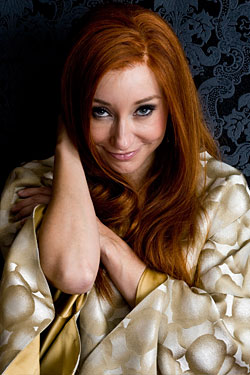|

songs | interviews | photos | tours | boots | press releases | timeline
Vulture (US, www)
New York Magazine's culture blog
November 11, 2009

Tori Amos on How and Why She Made a Christmas Album
By Michael D. Ayers
It's been a busy year for singer-songwriter Tori Amos: After releasing her tenth studio album, Abnormally Attracted to Sin, in May, she found time during the ensuing tour to record her first holiday-themed record, Midwinter Graces, which arrived in stores yesterday. Her dramatic piano lines are intact, but the album deviates from Amos's traditional style (most notably, it includes Christmas songs). As the daughter of a Reverend, Amos grew up surrounded by theology, and Graces is steeped in interpretations of old religious hymns. Vulture spoke with Amos about her new album on the phone from her home studio in Cornwall, England.
How did your upbringing influence this album?
There's all kinds of memories. I remember driving to North Carolina when
I was a little girl in a snowstorm to get down to my mom's family in the Carolinas. There were chains on the car -- it was the late sixties -- and we were just singing in the car. Christmas carols. And it was one of those things where of all the music that my dad turned me on to, the Christmas carols are what I related to a lot more than any religious music that the Methodists were pushing.
But these songs don't stick to classical interpretations.
I love the classic crooners, but I got that from my mother -- she worked in a record store. But my dad was a minister, so ...
It's more hymnal based.
Oh yeah. But during research I thought, Why does this music sound better than the other hymns? Little did I know at the time, but a lot of those songs used to be popular drinking songs and sea shanties for the Brits. "Nowell" -- the correct spelling is N-O-W-E-L-L -- there's this book called the Oxford Book of Carols which tells you the origins of the melodies. Some of them go back so far. And what would happen is, these new denominations would be popping up and they'd think, "Oh, God, we need some hit songs." So they'd take a popular song and put Christology to it. I've carried on the tradition. I've done variations of the themes that were variations of the themes.
What are some of the variations?
I did go to the Peabody Conservatory and figured that it needed to come in handy somewhere down the line. So I decided [to] bring in the string section, bring in the big band. And I love the big band and I think that's where you get the song "Pink & Glitter." And I think that was inspired by those old crooner songs.
Is writing in this style harder for you?
Well, in order to make this kind of record and to have it work, I needed to know what the carol writers were doing, then you need to know the theology of where it came from in order to change it. I did change it in making it more inclusive rather than exclusive. Because some of these lyrics were written, it was in a very puritanical time. Women had no rights, they couldn't vote. Some of the music would've been fifteenth century.
[source]
t o r i p h o r i a
tori amos digital archive
yessaid.com
|